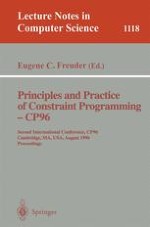1996 | ReviewPaper | Chapter
Combination of constraint systems II: Rational amalgamation
Authors : Stephan Kepser, Klaus U. Schulz
Published in: Principles and Practice of Constraint Programming — CP96
Publisher: Springer Berlin Heidelberg
Included in: Professional Book Archive
Activate our intelligent search to find suitable subject content or patents.
Select sections of text to find matching patents with Artificial Intelligence. powered by
Select sections of text to find additional relevant content using AI-assisted search. powered by
In a recent paper, the concept of “free amalgamation” has been introduced as a general methodology for interweaving solution structures for symbolic constraints, and it was shown how constraint solvers for two components can be lifted to a constraint solver for the free amalgam. Here we discuss a second general way for combining solution domains, called rational amalgamation. In praxis, rational amalgamation seems to be the preferred combination principle if the two solution structures to be combined are “rational” or “non-wellfounded” domains. It represents, e.g., the way how rational trees and rational lists are interwoven in the solution domain of Prolog III, and a variant has been used by W. Rounds for combining feature structures and hereditarily finite non-wellfounded sets. We show that rational amalgamation is a general combination principle, applicable to a large class of structures. As in the case of free amalgamation, constraint solvers for two component structures can be combined to a constraint solver for their rational amalgam. From this algorithmic point of view, rational amalgamation seems to be interesting since the combination technique for rational amalgamation avoids one source of non-determinism that is needed in the corresponding scheme for free amalgamation.
